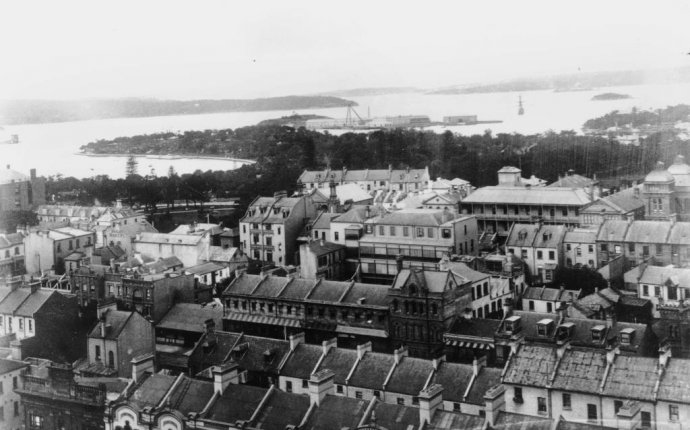
Australia Hotel Sydney History
Australia Hotel
architect
No info available.location
Castlereagh Street at Martin Place, Sydneydate
1889-1971style
, with later make-overconstruction
The hotel had a large entrance onto the street in polished granite, the stairs grey, the doric columns red. The squared columns in the entrance foyer were imported Italian marble, and the magnificent neo-classical staircase which led from the main foyer to the first floor was completely in Carrara marble in several colours. From that floor to the 10th a massive carved and highly polished mahogany Victorian grand staircase led to their rooms those guests, who, in the early days of lifts, still preferred to walk.type
The Australia Hotel in Castlereagh Street, Sydney, was until its closure on June 30, 1971, the premier hotel in Sydney, describing itself as "The Hotel of the Commonwealth". Above- Original Victorian facade Above- view circa 1900 showing how the GPO and the Australia Hotel dominate the skyline. A patron stands on the marble steps of the doomed Hotel Australia. The closure notice is pasted on a column, and, left, revised art deco facade c. 1930. Glamorous hotel in Castlereagh Street built in 1891 which was extended in the 1920s with an Art Deco entrance from Martin Place. It was demolished in 1971 and is now the site of the MLC Centre.Combining an ornate nineteenth-century facade in Castlereagh Street, with an Art Deco fantasy of black marble and silver in Martin Place, the Hotel Australia was one of Sydney's most elegant until its demolition in 1972, when the MLC Centre was built.
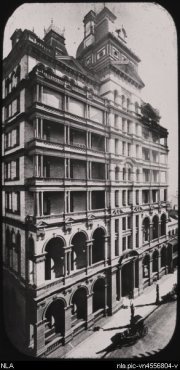 Above- the site in 1930 and 2014.
The Hotel Australia and the Commercial Travellers Club would both have fit into the forecourt of the MLC Centre (not quite Harry's style though!).
Above- two images of the corner of Castlereagh and Martin Place, showing the Commercial Travellers Club in front of the Hotel Australia.
Above- famous guests.
Above- the view from the roof.
Situated in one of Sydney's important thoroughfares in the heart of the city, the hotel's foundation stone was laid by Sir Henry Parkes in 1889, and the opening of the new establishment was performed by Sarah Bernhardt, whose name was first in the new hotel register, subsequently displayed in a glass showcase in the main foyer.The first floor contained a pillared corridor with various reception rooms, in addition to the Winter Garden - "famous for its morning and afternoon teas, light luncheons, and theatre suppers", and the Moorish Lounge, leading to the huge dining room - the Emerald Room, with its highly decorated ceiling some 20 feet above the guests, Italian chandeliers, and a dias at the west end containing a white marble operating fountain and other statues, engulfed in palm court style shrubbery.The hotel boasted international standards of comfort and service. Robert Helpman had a suite permanently reserved should he need it; one lady stayed there for 31 years. Apart from the accommodation for guests, rooms were also provided in the Rowe Street wing for their servants, including the children's nurses, who had their own dining room with their charges.In 1910 the ‘Australasian Wireless Company’ obtains a licence from the PMG to run telegraphy tests with ships at sea on 27 August. It was permitted to handle commercial traffic in 1911 – the first in Australia. It was located at the 6th floor of ‘The Hotel Australia’.In the 1920s an extension was constructed to the north of the main hotel which fronted on to the city's historic Martin Place. A highlight of this block was its circular art deco black glass staircase.The hotel remained an oasis for those who scorned modernity and sought the more refined atmosphere of the classic European hotels.In 1968 the Hotel Australia was purchased by the huge MLC Insurance and Finance group who, with mounting concern, announced their intention of refurbishing and maintaining one of the city's landmarks. However the following year they announced its impending closure and later demolished it in almost record time, to erect a modern $20 million dollars 35 storey office block/skyscraper in its place, the MLC Centre. (MLC was purchased in 2000 by the National Australia Bank).The Royal Australian Historical Society who fix their famous Green Plaques to historic buildings and sites, placed their 39th plaque on the MLC Centre in memory of the Australia Hotel.References^ Sydney Harbour Bridge Official Souvenir & Programme, NSW Government Printer, 1932, p.128
Above- the site in 1930 and 2014.
The Hotel Australia and the Commercial Travellers Club would both have fit into the forecourt of the MLC Centre (not quite Harry's style though!).
Above- two images of the corner of Castlereagh and Martin Place, showing the Commercial Travellers Club in front of the Hotel Australia.
Above- famous guests.
Above- the view from the roof.
Situated in one of Sydney's important thoroughfares in the heart of the city, the hotel's foundation stone was laid by Sir Henry Parkes in 1889, and the opening of the new establishment was performed by Sarah Bernhardt, whose name was first in the new hotel register, subsequently displayed in a glass showcase in the main foyer.The first floor contained a pillared corridor with various reception rooms, in addition to the Winter Garden - "famous for its morning and afternoon teas, light luncheons, and theatre suppers", and the Moorish Lounge, leading to the huge dining room - the Emerald Room, with its highly decorated ceiling some 20 feet above the guests, Italian chandeliers, and a dias at the west end containing a white marble operating fountain and other statues, engulfed in palm court style shrubbery.The hotel boasted international standards of comfort and service. Robert Helpman had a suite permanently reserved should he need it; one lady stayed there for 31 years. Apart from the accommodation for guests, rooms were also provided in the Rowe Street wing for their servants, including the children's nurses, who had their own dining room with their charges.In 1910 the ‘Australasian Wireless Company’ obtains a licence from the PMG to run telegraphy tests with ships at sea on 27 August. It was permitted to handle commercial traffic in 1911 – the first in Australia. It was located at the 6th floor of ‘The Hotel Australia’.In the 1920s an extension was constructed to the north of the main hotel which fronted on to the city's historic Martin Place. A highlight of this block was its circular art deco black glass staircase.The hotel remained an oasis for those who scorned modernity and sought the more refined atmosphere of the classic European hotels.In 1968 the Hotel Australia was purchased by the huge MLC Insurance and Finance group who, with mounting concern, announced their intention of refurbishing and maintaining one of the city's landmarks. However the following year they announced its impending closure and later demolished it in almost record time, to erect a modern $20 million dollars 35 storey office block/skyscraper in its place, the MLC Centre. (MLC was purchased in 2000 by the National Australia Bank).The Royal Australian Historical Society who fix their famous Green Plaques to historic buildings and sites, placed their 39th plaque on the MLC Centre in memory of the Australia Hotel.References^ Sydney Harbour Bridge Official Souvenir & Programme, NSW Government Printer, 1932, p.128
^ Daily Mirror, Sydney, Monday, March 31, 1969, p.22
Sydney Harbour Bridge Official Souvenir & Programme, NSW Government Printer, 1932, p.128.
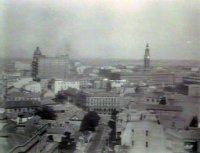
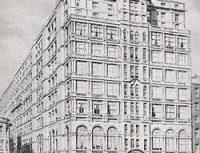
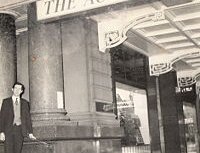
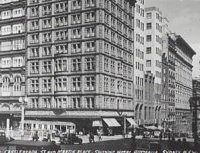
Source: sydneyarchitecture.com









